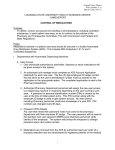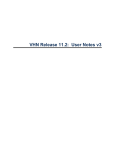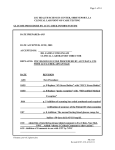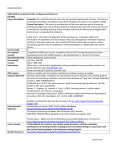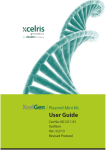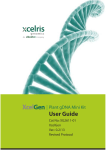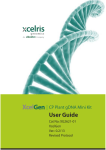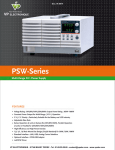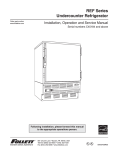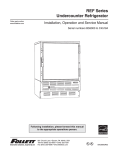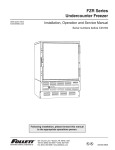Download 8.13 Control of Medications - Louisiana State University Health
Transcript
Hospital Policy number: 8.13 Effective Date: 8/01/04 LOUISIANA STATE UNIVERSITY HEALTH SCIENCES CENTER SHREVEPORT CONTROL OF MEDICATIONS Purpose: To define, control, and secure the handling of all medications, including controlled substances, in each patient care area, so as to conform to the policies of the Pharmacy and Therapeutics Committee, JCAHO, and Federal and State Regulations. Policy: Medications stocked in a patient care area should be secured in a locked Automated Drug Distribution System (ADS). This includes DEA Schedule II, III, IV and V Controlled Substances. I. Departments with Automated Dispensing Machines A. User Access 1. Only individuals authorized to administer, dispense or stock medications will be given access to the system. 2. An authorized unit manager must complete an ADS Account Application (attached) for each new user. The five (5) digit employee ID badge number that will serve as the user’s identification number must be entered on the application in the appropriate space. The completed application is sent to the Pharmacy Department. 3. Authorized Pharmacy Department personnel will assign the new user access to a dispensing machine or machines depending on the user’s primary work area. A password or personal identification number (PIN) is chosen by the user at the time of initial system entry. This PIN number along with the employee ID badge is used to gain system access. No other person, including Pharmacy personnel, shall have knowledge of a user PIN. PIN numbers are changed every 90 days. 1 Hospital Policy number: 8.13 Effective Date: 8/01/04 B. 4. Medications are removed from the ADS by authorized users per order of a licensed prescriber and are administered to registered patients of the medical center. Staff (exception Residents) shall not routinely procure medications from ADS for personnel with access. 5. User training is the responsibility of unit personnel in the user’s primary work area. Once training is completed a written competency assessment is required. The manager for the user’s primary work area is responsible for assuring that proper training and competency assessment is performed. 6. Each unit manager will notify appropriate pharmacy personnel as soon as possible when an employee with ADS access rights terminates, transfers to another work area, or is demoted and no longer needs access privileges. Pharmacy personnel will remove user access to the ADS immediately once this notice is received. Dispensing Medications are stored in the ADS in a unit dose module, a drawer module, a supply cabinet or a locked refrigerator. Adequate supplies of designated medications are maintained in each ADS by the Pharmacy Department. 1. Unit dose module (UDM): Most controlled substances are stocked in a UDM. The UDM dispenses a single dose of medication for each dose requested. Each user will assure the correctness of the drug and quantity dispensed by the UDM. Each user will report all failures by the UDM to dispense correctly through the use of a discrepancy button. 2. Drawer, supply cabinet, or refrigerator: When a medication stored in one of these areas is requested, the drawer or door of the supply cabinet or refrigerator opens. The user then removes the requested drug and the requested number of doses. If a controlled substance, the user must count and 2 Hospital Policy number: 8.13 Effective Date: 8/01/04 enter into the ADS the number of doses remaining in the position. 3. 4. Waste: a. If necessary to administer a partial dose of a controlled substance, an authorized witness must observe the entire waste. The disposal must render the product unrecoverable. User and witness must document waste in the ADS. b. Fentanyl patches should be folded in half with the stick sides together and disposed in the sharps container. The nurse removing the patch should be careful not to touch the sticky side of the patch. Document the waste on the patient’s MAR. A witness and signature are required. c. Dispose of I.V. tubing containing a controlled substance in the “sharps” box at the nursing station. Returns: All unused medications are to be returned to the ADS. When a return is entered into the ADS, the return drawer or the original supply position will open to allow placement of the medication. No partial or opened containers shall be returned to the ADS. Partial or opened container contents should be wasted as described above. C. Discrepancies The ADS maintains a perpetual inventory for each stocked and returned controlled substance. A count discrepancy occurs when a user enters a count, either on a supply position or return drawer that does not agree with the count maintained by the ADS. 1. All ADS users are responsible for the maintenance of accurate supply counts and accurate controlled substance records. 3 Hospital Policy number: 8.13 Effective Date: 8/01/04 D. 2. Dispensing and count discrepancies are noted through the use of the ADS discrepancy button. 3. If a user fails or cannot note a discrepancy through the use of the ADS discrepancy button, then the user will submit a written explanation of the discrepancy to the Pharmacy Department through the use of a Problem Reporting Form. Problem Reporting Forms can be found on each unit where an ADS is located. 4. All controlled substance discrepancies must be resolved through the entry of an acceptable explanation into the ADS. Pharmacy personnel will attempt to resolve each discrepancy on the day that it is first noted through the use of available reports or contact with involved users or unit managers. 5. A variance report will be completed and submitted by Pharmacy to the Hospital Quality Management department for each discrepancy involving a controlled substance that cannot be resolved or explained in a timely manner. 6. Pharmacy management will monitor and track discrepancies and discrepancy resolution. Discrepancy reports will be submitted to Hospital and Nursing Administration and the Pharmacy and Therapeutics Committee on a regular basis. ADS Problems All problems with the ADS should be immediately reported to Pharmacy department personnel. II. Medication Storage in Areas Without an Automated Dispensing Machine Areas without an automated drug distribution system shall store medications according to the following guidelines. A. Medications are stored under conditions to ensure stability. B. All medications including nonprescription medications are in locked containers in a room or are under constant surveillance by appropriate personnel. 4 Hospital Policy number: 8.13 Effective Date: 8/01/04 III. IV. V. C. Medications that are easy to confuse (sound alike and look alike drugs or reagents or chemicals that may be mistaken for medications) are segregated. D. All medication storage areas are periodically inspected according to department policy to ensure medications are stored properly. E. Medications and chemicals used to prepare medications are accurately labeled with: 1. Contents 2. Expiration dates 3. Appropriate warnings Emergency Drugs A. The Special Care Committee reviews emergency medications stocked on crash carts periodically. B. Pharmacy will provide crash cart medications in sealed drawers to Central Medical Supply (CMS) to be placed in cleaned, refilled crash carts immediately prior to locking. Management of Automated Dispensing Machine Data A. The ADS maintains electronic records of all transactions involving the medications stocked within. These records are not a substitute for proper charting of the administered medications. B. Nursing Managers will analyze and respond to management reports that are generated from automated medication and documentation systems. Response to reports will be kept on file for one year. Downtime Procedures – Electricity is available to ADS 5 Hospital Policy number: 8.13 Effective Date: 8/01/04 VI. A. The nurse or pharmacist identifies some or all computer system communications are disrupted and informs the opposite department (Nursing/Pharmacy). B. The pharmacist calls computer services help desk to verify extent of system affected. C. If diagnosis and repair can’t be completed quickly, pharmacy will contact the nursing house manager and request the switchboard to announce outage through the overhead paging system. D. If the senior pharmacist determines that medication procurement for patients will be seriously affected by operating with partial computer information systems, the pharmacy will disconnect MedSelect server. This will allow all stocked medications to be obtained through over-ride. Med Select will display a red header indicating network communications are interrupted. Med Order will not be available. E. The RN, RN applicant, or LPN will create a manual MAR (Medication Administration Record) using the previous day’s MAR and by reviewing physicians orders. F. The nurse shall not reboot the automated dispensing machine, as this will cause the machine to become inoperable. G. The patient care unit will write the floor/unit on all copies of physician orders sent to the pharmacy. H. In the event that the pneumatic tube system is down and a stat dose is needed, the unit shall send a runner to obtain the medication. Routine medications can be picked up by anyone on the floor; a licensed nurse will pick up narcotics. I. For more detailed information, refer to the Med Select User Manual on your unit. Downtime Procedures – No electricity A. Notify pharmacy immediately. B. The pharmacy will provide keys to the units as needed. 6 Hospital Policy number: 8.13 Effective Date: 8/01/04 C. The Charge Nurse will put the form “MedSelect – Backup Manual Transactions on the ADS. All medication transactions shall be documented on this form. The pharmacy will pick these forms up after electricity has been restored. This document does not replace the MAR. D. Please refer to the Med Select User Manual on your unit. _______________________ Administrator ___7/21/04____________ Date Approved by Clinical Board 1/16/01. 4/20/04, 7/20/04 Written: 1/01 Revised: 2/04, 6/04 Reviewed: 12/03 7 Hospital Policy number: 8.13 Effective Date: 8/01/04 DIEBOLD/MEDSELECT COMPETENCY ASSESSMENT Name __________________________ SS# ________________ Unit_________ Procedure/Task Met Not Met Met Not Met Log In III. 1. Assignment of ID and PIN number 2. Machines that can be accessed by employee 3. How to log in 4. How to change PIN 5. What to do when you forget your PIN IV. Patient Selection 1. How to pick a patient 2. How to Find/Add a patient not on the screen (can only get overridden meds) 3. Explain importance of entering medical record number of patient added V. Machine Set Up 1. Explain the difference in unit dose module, drawer module, supply cabinets, and refrigerator Med Order Display 1. Explain the difference between medications written in black or gray print a. black print means the medication is available from the machine b. gray print means the medication is not available from the machine and must be dispensed as a patient specific order from the pharmacy 2. Explain reason why some medications are not available on the machine a. out of stock b. position failed c. medication is seldom used or not stocked on machine 3. Demonstrate how to select medication by generic or trade name 4. Explain the significance of the number in parentheses after a medication name 5. Explain the significance of a dark black arrow to the right of the medications listed 6. Demonstrate that the dose will disappear from the screen after the scheduled medication is given 7. Observe that scheduled medication are displayed first, according to due time, then PRNs Procedure/Task 8 Hospital Policy number: 8.13 Effective Date: 8/01/04 Due Window VI. 1. 2. VII. 1. 2. VIII. 1. Observe that scheduled medications appear on the screen two (2) hours before they are due Observe that only scheduled medication falling within the due time will be displayed Late Window Observe that a medication not given by its due time will appear highlighted in yellow Explain that after four (4) hours after due time the medication will no longer be displayed/available for dispensing a. a variance should be written per hospital policy Dismiss Demonstrate how a scheduled medication not administered for a clinical reason should be dismissed from the screen (if a scheduled medication is not dispensed, it will print to an error report) Misc Buttons IX. 1. 2. 3. Explain the rationale for the Hide Meds button Explain the rationale for the Hide PRN’s button Demonstrate the use of the Hide IV’s button Med Supply Button X. 1. Explain what Med Supply Button is used for (dispense medications or as override situation) 2. Demonstrate how to select medication “Kit” if applicable Controlled Substances XI. 1. 2. 3. 4. 5. XII. 1. 2. 3. 4. Demonstrate how to count drug remaining in drawer/cabinet/ refrigerator Explain what happens when count is incorrect Explain what to do when medication is not dispensed in the correct quantity Demonstrate/Explain use of Discrepancy Button Explain what to do when system says call the system Administrator Returns and Wastes Explain importance of medication units (i.e. mg, mcg, vl) in return and waste Demonstrate how to return medication to machine Demonstrate/explain how to record and witness waste Discuss/Explain how returning or wasting a full scheduled dose will return that dose to the MedOrder screen 9 Hospital Policy number: 8.13 Effective Date: 8/01/04 Troubleshooting 1. What to do when the screen is blank 2. What to do when screen freezes 3. What to do when medication not displayed on screen Met XIII. Not Met Procedure/Task Printers 1. How to obtain paper for the printer 2. How to add paper to printer 3. How to read the printout XIV. Logging Off 1. How to log off machine 2. Explain the importance of logging off after use *Managers 1. How to request employee access from pharmacy 2. How to give temporary employee access 3. How to read discrepancy log 4. How to read reports 5. How to correct a counting discrepancy Qualified Observer Signature _______________________________ Date ________ Employee Signature ______________________________________ Date ________ NOTE: When everyone on the unit has completed the checklist, send lists as a group to Patient Care Support/Education for documentation on computerized education record. 10 Hospital Policy number: 8.13 Effective Date: 8/01/04 DIEBOLD AND MEDSELECT COMPETENCY CHECKLIST Print Name: _______________________________ Unit: _____________________________________ Date Reviewed CD Rom: ______________________ Date Competency Assessment Completed: __________________________ The above competencies have been met. Qualified Observer Signature: __________________________ Date: ____________ Employee Signature: _________________________________ Date: ____________ *PLEASE RETURN THIS FORM TO YOUR MANAGER* 11 Hospital Policy number: 8.13 Effective Date: 8/01/04 LSU HEALTH SCIENCES CENTER ADS (DIEBOLD) USER ACCESS APPLICATION FIRST LAST NAME: NAME: _________________________ USER NUMBER: ____ ____ ____ ____ ____ (This number must be entered—5 digit number on back of employee ID badge) USER’S PRIMARY WORK AREA: _______________ GROUP PROFILE (Check one) q q q q q q q q (examples listed below) Nurse - Staff Nurse - Manager Nurse – Contract (ending date____________) CRNA / SRNA No Controlled Other ________ Physician - Anes Physician - Samples o User has a signed copy of the LSUHSC Confidentiality Agreement in their employee file. UNIT MANAGER /AUTHORIZED SIGN: _____________________________________DATE: __________ PHONE: ________________ SEND TO PHARMACY WHEN COMPLETE INCOMPLETE APPLICATONS WILL BE RETURNED PHARMACY WILL CONTACT MANAGER WHEN USER IS ENTERED INTO SYSTEM ___________________________________________________________________________ ___ For pharmacy use only ENTERED into The Automated Drug Dispensing Machine: BY: ________________ DATE: _______________ 12 Hospital Policy number: 8.13 Effective Date: 8/01/04 MANAGER CONTACTED: DATE: _____________TIME: ____________BY: ____________ 13 Hospital Policy number: 8.13 Effective Date: 8/01/04 ADS PROBLEM REPORT This form must be completed when any problem is encountered while using an automated dispensing machine. If the problem has been reported through the use of the “Discrepancy Button” it is not necessary to complete this form. Fill out completely so that appropriate adjustments can be made to the patient bill and controlled substance records. Date of Event: ________ Time: __________ Location: __________ Patient Name: _________________________ Medical Record #: _________________ Medication: ___________________________ Detailed description of problem: Once completed, place in tray for completed forms located in the vicinity of the dispensing machine so that it may be retrieved by pharmacy personnel. Employee Signature: _____________________ Date: ___________ Signature of witness is required for documentation of controlled substance waste. Witness Co-Signature: ____________________ Date: ___________ 14 Hospital Policy number: 8.13 Effective Date: 8/01/04 15 Hospital Policy number: 8.13 Effective Date: 8/01/04 MedSelect - BACKUP MANUAL TRANSACTIONS P ATIENT NAME MR # MEDICATION (INCLUDE STRENGTH AND DOSAGE FORM) # DOSES DISPENSED # DOSES RETURNED AMOUNT WASTED RN SIGNATURE/CO-SIGNATURE (WASTE MUST INCLUDE CO-SIGNATURE) 16 Hospital Policy number: 8.13 Effective Date: 8/01/04 17

















